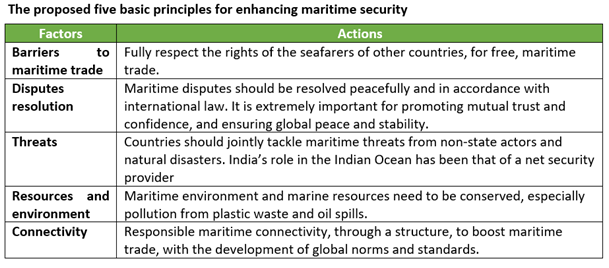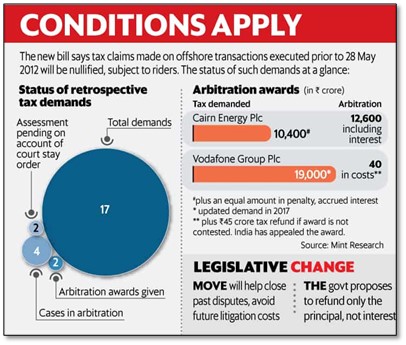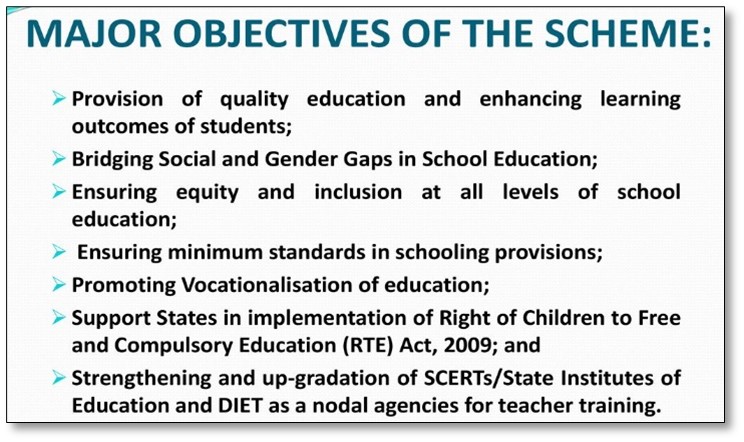Wednesday, 11th August 2021
Atlantic Meridional Overturning Circulation (AMOC)
In News
According to the IPCC’s Report (AR6) released on August 9, it is very likely that Atlantic Meridional Overturning Circulation (AMOC) will weaken over the 21st century.
Findings of the report
- Critical Threshold: AMOC decline is not just a fluctuation or a linear response to increasing temperatures but likely means the approaching of a critical threshold beyond which the circulation system could collapse.
- Changes in Weather patterns: If such a collapse were to occur, it would very likely cause abrupt shifts in regional weather patterns and water cycle, such as
- A southward shift in the tropical rain belt, weakening of the African and Asian monsoons and strengthening of Southern Hemisphere monsoons, and drying in Europe.
- A prominent cooling over the northern North Atlantic and neighbouring areas, sea ice increases over the Greenland-Iceland-Norwegian seas and to the south of Greenland.
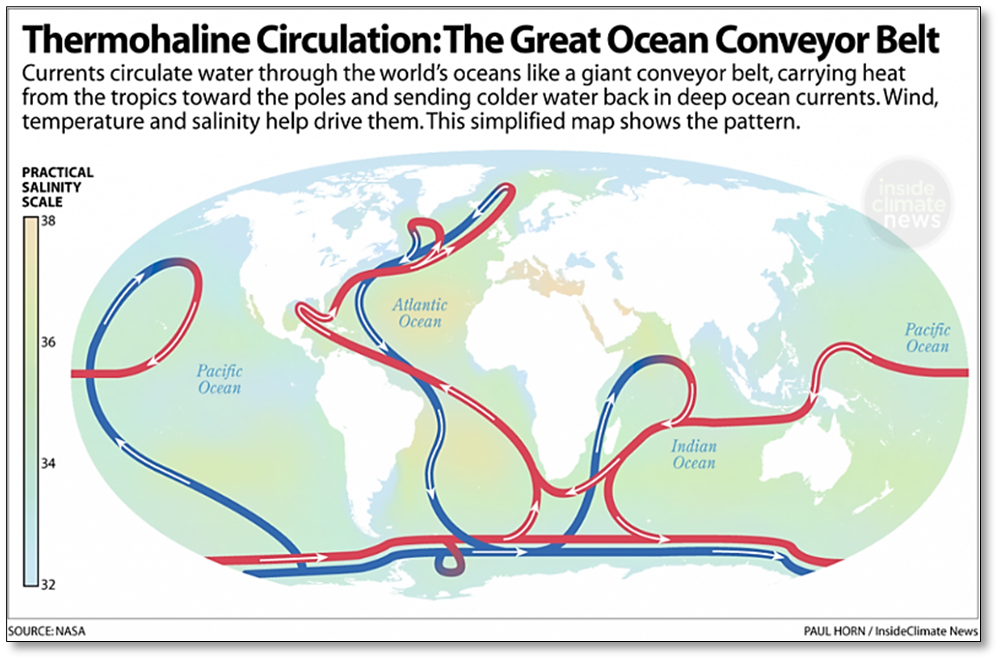
What is Atlantic Meridional Overturning Circulation (AMOC)?
- The AMOC is a large system of ocean currents. It is the Atlantic branch of the ocean conveyor belt or Thermohaline circulation (THC). It distributes heat and nutrients throughout the world’s ocean basins.
- AMOC carries warm surface waters from the tropics towards the Northern Hemisphere, where it cools and sinks. It then returns to the tropics and then to the South Atlantic as a bottom current. From there it is distributed to all ocean basins via the Antarctic circumpolar current.
Reason for weakening of AMOC
- Global warming and Melting glaciers: The freshwater from the melting ice reduces the salinity and density of the water. As this water is unable to sink as it used to, it weakens the AMOC flow.
- Increasing precipitation in the Indian Ocean: As the Indian Ocean is warming at a faster rate, it generates additional precipitation. This draws more air from other parts of the world to the Indian Ocean, including the Atlantic. High precipitation in the Indian Ocean, thus leads to less precipitation in the Atlantic Ocean. This causes higher salinity in the waters of the tropical portion of the Atlantic. This saltier water in the Atlantic, as it comes north via AMOC, will gets cold much quicker than usual and sinks faster.
Source:
- Is Indian Ocean helping Atlantic currents?
- Source -Explained: Why the Atlantic Ocean current system is slowing down, and its implications
Image Source:
‘Elderly in India 2021’ Report
In News: The Ministry of Statistics and Programme Implementation (MOSPI) has published the ‘Elderly in India 2021’ Report that provides insights about the status of elderly persons in the country.
Key Findings of the Report
- The percentage share of the elderly population in the total population is said to rise from 8.6% in 2011 to 10.1% in 2021 and projected to touch 13.1% in 2031.
- Kerala has the highest share of elderly in population at 16.5% and Bihar has the lowest at 7.7%.
- Increase in old age dependency ratio which rose from 10.9% in 1961 to 14.2% in 2011, is projected to increase from 15.7% and 20.1% in 2021 and 2031 respectively.
- Literacy levels among elderly males and females have improved over time in both rural and urban areas. However, the report noted a huge gender gap with over 59% elderly male literates as against only 29% elderly female.
- The major problems of the aged people, as found by the report include economic, physiological and crime.
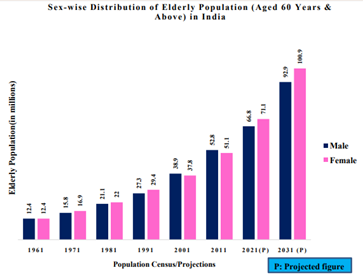
Schemes and Programmes of Government of India for the Welfare of Elderly Persons
The Department of Social Justice and Empowerment develops and implements programmes and policies for senior citizens.
- National Policy on Older Persons (NPOP), 1999: envisaged state support to ensure financial and food security, health care, shelter and other needs of older persons, equitable share in development, protection against abuse and exploitation, and availability of services to improve the quality of their lives.
- Maintenance and Welfare of Parents and Senior Citizens Act, 2007: to ensure need based maintenance for parents and senior citizens.
- National Awards for Senior Citizens-Vayoshreshtha Samman: to recognize the efforts made by eminent senior citizens and Institutions involved in rendering distinguished services for the cause of elderly persons.
- Rashtriya Vayoshri Yojana (RVY): Scheme for providing Physical Aids and Assisted-Living Devices for Senior Citizens.
- Indira Gandhi National Old Age Pension Scheme (IGNOAPS): Senior citizens above 60 years of age are entitled to a monthly pension without having to contribute any sum in order to get the pension.
- National Action Plan for the Welfare of Senior Citizens (NAPSrC), Pradhan Mantri Vaya Vandana Yojana (PNVVY) are other such schemes.
Source:
Image Source:
Human Influence on Global Warming
In News
Recently release IPCC AR6 report highlights that human influence has warmed the climate at a rate that is unprecedented in at least the last 2,000 years.
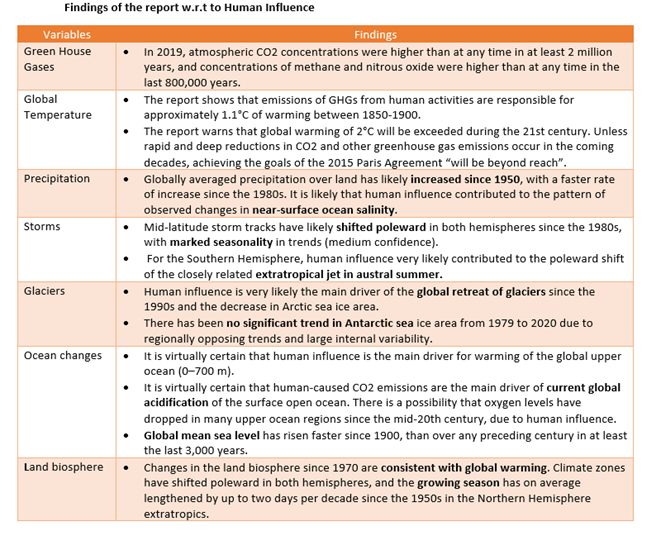
Source:
Nanotechnology in Agriculture
In News
Indian Farmers Fertilizers Cooperative Limited (IFFCO) has introduced the world's first Nano Urea, an innovative solution for reducing environmental pollution and soil health.
About the News
- IFFCO has also sought permission from the Department of Fertilizers for the export of Nano Urea (liquid) manufactured from its Nano Fertilizer Plant facility set up at Kalol, Gujarat.
- Experimental trials of Nano Nitrogen undertaken during Rabi/Zaid 2019-20 at ICAR research institute/state agricultural Universities on different crops were found agronomically suitable indicating that nano nitrogen (Nano Urea) can enhance farmer's crop yields besides saving nitrogen to the extent of 50 per cent.
What is nanotechnology?
- Nanotechnology refers to controlling, building, and restructuring materials and devices on the scale of atoms and molecules. A nanometre (nm) is one-billionth of a meter. At nano scales, the basic rules of chemistry and physics are not applicable.
- One example of this technology is the carbon nanotube discovered in 1991, which is only a few nanometers in diameter but can conduct electricity better than copper; 100 times stronger than steel but only one sixth of its weight.
How can nano-technology be applied to the field of agriculture?
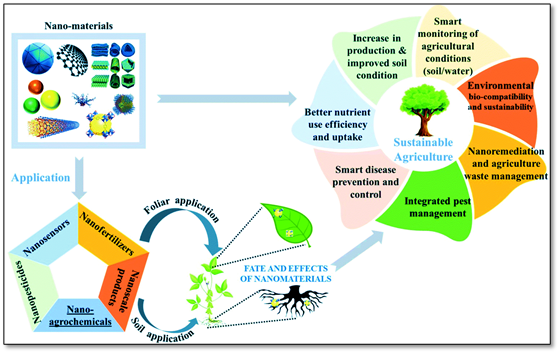
- Nanoscale carriers: Nanoscale carriers can serve as ‘magic bullets’, containing herbicides, chemicals, or genes, which target particular plant parts to release their content. Nano-capsules can enable effective penetration of herbicides through cuticles and tissues, allowing slow and constant release of the active substances.
- Nanofabrication: Nanofabrication is the design and manufacture of devices with dimensions measured in nanometers. It can enable the study of plant’s regulation of hormones such as auxin, which is responsible for root growth and seedling establishment. It helps understand how plant roots adapt to their environment, especially to marginal soils.
- Photocatalysis: It involves the reaction of catalyst (nanoparticles) with chemical compounds in the presence of light. Through this process, nanoparticles can be used for the bioremediation of resistant or slowly degradable compounds like pesticides, as Disinfectants and for Wastewater treatment.
- Nano barcode technology: Nano barcodes have been used as ID tags for gene expression analysis. Nano particles to be utilized in nano barcodes are easily encodeable, machine-readable, durable, sub-micronsized taggant particles.
- Nanosensors: Through the use of nano- Sensors and GPS with satellite imaging of fields, farmers can remotely detect crop pests or evidence of stress such as drought. By using electronic sensors, fertilizers can be placed precisely in moist zone, based on the spatial variability in native fertility.
- Smart Dust: The ‘smart dust’ technology can be used for monitoring various parameters like temperature, humidity, and perhaps insect and disease infestation to create distributed intelligence in vineyards and orchards.
- Nano- materials: Products based on nano-materials are being developed to absorb soil moisture when it is in excess and release slowly to plants during dry periods.
- Livestock Upkeep: Nano-technology can be utilised to enhance livestock production and health. Food and nutritional products containing nano-scale additives, nano-sized, multi-purpose sensors to assess the physiological status of animals. Nano-particles may enhance nutrient uptake and help in efficient utilisation of nutrients for milk production.
Benefits of Nano-technology in Agriculture
- Eco-friendly: Mechanisms like Nano-scale carriers help improve stability against degradation in the environment and ultimately reduce the amount of pesticides to be applied, which reduces chemical runoff and alleviates environmental problems. It helps reduce the amount of inputs to be used and also the waste produced.
- Yield Increase: Precision farming techniques might be used to further improve the crop yields but not damage soil and water. Nanotechnology applications include nanoparticle-mediated gene or DNA transfer in plants for the development of insect-resistant varieties, food processing and storage and increased product shelf life.
- Economic Benefits: Nano technology has subsidized the agricultural based business sector with annual growth rate of 25% (US$ 1.08 billion). It is estimated that integration of advanced nanotechnology in agriculture would thrust the global economic growth to ∼ US$ 3.4 trillion.
- Cope with Global challenges: This integrating approach, i.e., agri-nanotechnology has great potential to cope with global challenges of food production/security, sustainability, and climate change.
Challenges in use of nanotechnology in agriculture
- Human Resources: To be successful in the novel emerging field of agricultural nanotechnology, human resources must be well trained to experiment, innovate, assess, interpret, and successfully assimilate the theory, tools, and techniques of nanotechnology for its application in agriculture.
- Concerns at various levels: The concerns related to the availability, synthesis, level of toxicity, health hazards, transportation challenges and incongruity of regulatory structure restrict the broad recognition and acceptance of adopting nanotechnology in agriculture.
- Lack of Risk Assessment: The current research trends lack realistic approach that fail to attain comprehensive knowledge of risk assessment factors and further toxicity of nanoparticles toward agroecosystem components viz. plant, soil, soil microbiomes after their release into the environment.
Conclusion
The opportunity for application of nanotechnology in agriculture is prodigious. Research on the applications of nanotechnology in agriculture is less than a decade old. Nevertheless, as conventional farming practices become increasingly inadequate, and needs have exceeded the carrying capacity of the terrestrial ecosystem, we have little option but to explore nanotechnology in all sectors of agriculture.
Question: Discuss the various applications of nanotechnology in agriculture. What are the potential benefits and concerns related to it?
Sources:
This Day in History - Operation Vijay
On August 11, 1961 the former Portuguese territories of Dadra and Nagar Haveli were merged to create the Union Territory of Dadra and Nagar Haveli. Both the UTs are located on India’s western coast near Gujarat. It was under Operation Vijay that the Military of India captured of Goa, Daman and Diu and Anjediva Islands from the Portuguese. The Portuguese had taken control of Dadra and Nagar Haveli in the year 1783 on the basis of a Friendship Treaty, as a compensation towards damage to a Portuguese warship by the Maratha navy. Later in 1785, the Portuguese purchased Dadra.
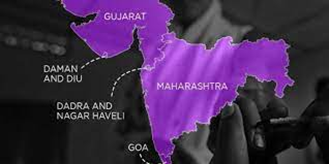
Sources:
Image of the Day - Biomimicry
This is the image of bio-inspired glue can seal wounds in just 15 seconds. Researchers at MIT have designed a strong, biocompatible glue that can seal injured tissues and stop bleeding, through Biomimicry. Biomimicry involves creating solutions inspired by nature. The new paste, inspired by the sticky substance that barnacles use to cling to rocks, can adhere to a surface even if it’s covered with blood, and can form a tight seal within about 15 seconds of application.

Source:
Census to go digital
- Context: The Centre has announced that the forthcoming census will be the first digital census.
- A mobile app for the collection of data and a census portal for management and monitoring of various census related activities have been developed.
- The portal will require the mobile phone numbers and other details of individuals for logging in and in the case of self-enumeration, an individual will have to fill in the required details with the help of relevant codes for each field.
- After self-enumeration, an identification number will be sent on the registered number provided by the individual which can be shared with the enumerator to help officials sync the data automatically.
- The individual data collected in Census under the Census Act, 1948 are not made public as per the provisions contained in the Act and will not be used for the preparation of any other databases such as the National Register of Citizens.

Source:
Image Source:
PM-KISAN - Edukemy Current Affairs
- Context: Release of 9th instalment of financial benefit under Pradhan Mantri Kisan Samman Nidhi (PM-KISAN).
- PM-KISAN is a Central Sector scheme launched in 2018 by the Ministry of Agriculture and Farmers Welfare.
- Under the scheme, the Central government provides income support to farmers of Rs 6,000 per year in three equal instalments, directly into the bank accounts of all landholding farmers irrespective of the size of their land holdings.
- The State Government and UT administration will identify the farmer families which are eligible for support as per scheme guidelines.
- Taxpaying citizens, professionals like doctors, engineers or lawyers, institutional landholders, families holding constitutional posts or retired person with pension of more than Rs 10,000 per month are not eligible for this scheme.

Source:
- PM-KISAN: A Look at Scheme, Eligibility & Benefits as PM Modi Releases 9th Installment for Farmers Today
- PM Kisan Samman Nidhi
Image Source:
India Internet Governance Forum
- Context: The India Internet Governance Forum (IIGF) was launched recently.
- Internet Governance Forum is an UN-based forum that acts as a policy discussion platform to bring representatives together from various groups to discuss public policy issues related to the Internet.
- This mode of engagement is referred to as the multi-stakeholder model of Internet Governance- the key feature for the Internet’s success.
- India is the second-largest broadband subscription country in the world and has the highest data consumption per user per month.
- IIGF initiative ensures that the growth of broadband adheres to the lifestyle and requirements of the Indian community.
- The theme of the event is "Inclusive Internet for Digital India".

Source:
Image Source:
Sitanadi Udanti Tiger Reserve
- Context: The Chhattisgarh Government has recognized the community forest resource rights of five villages spread within the core area of Sitanadi Udanti Tiger Reserve.
- Sitanadi-Udanti Tiger Reserve came into existence in the year 2008-09, are two separate reserves (Udanti & Sitanadi Wildlife Sanctuaries) combined together.
- It is located in the Gariaband district, Chhattisgarh.
- The Asiatic Wild Buffalo is the key endangered species found in the Core Area and apart from tiger.

Source:
Image Source:
Unpacking the resiliency of global trade, yet again
The article talks about the loss to economy due to the impact of covid-induced crisis. Countries have responded to the pandemic in various manners- protectionism, national aspirations, new supply chains. But the past trends indicate that every time there been a crisis, the economy has shown innovative methods to build its structure. Be it after the world war, or the oil shocks of 1970s, the financial crisis of 2008, etc. This performance from the past leaves much hope for these times of crisis. Technology, integration, trade, innovation, automation will contribute to resilience this time. Towards the conclusion, the article shows the way for India to develop its potential.
Why you should read this article?
- Understand the resilience of trade during various world-level disruptions
- Scope for India to develop in the present times of crisis
Source:
As climate deadline looms, a look at what science says, what politics delivers, and what the economy demands
Essence: We need to shift from sensational to strategic conversation while discussing about climate change and understand what the science says, politics delivers, and economy demands. Science has become better at attributing warming to human influence and extreme events to a changing climate. The world needs transformational change, but countries have more myopic outlooks. India is particularly vulnerable and hotspot of extreme weather events and must adopt a more climate-friendly development pathway for its own sake. Also, we need to shift the discourse from energy to the economy because there are very few sunrise sectors that are not low carbon. We need better technologies and business models along with policy and regulatory support to tackle the same.
Why should you read this article?
- To get an overview of climate change and its impact on India.
- To understand, why we need to shift from sensational to strategic conversation.
- To know what possible steps should be taken to tackle the same.
Source:
Xi Jinping’s visit to Tibet
Essence: This article sharply focusses on China’s increasing assertiveness in Tibet which is evident in the way China has accelerated the pace of infrastructure development in the region by building rail links and hydropower projects. The country is now a staunch believer of the fact that in order to strengthen its security, it has to secure its border for which China is taking steps in the form of changing the demography of the Tibet region and paying special attention to ‘patriotic education’.
Though India and China have been co-existing peacefully, India should brace itself for the new challenges that may creep in due to the increasing influence of Chinese in the north east.
Why you should read this article?
- To understand the recent developments that have taken place in the Tibetan Region.
- How the recent developments in Tibet could have an impact on India.
Source:
Technology is the savior for the future
Tool on NASA’s Sea Level Portal
- NASA has created a visualisation tool that makes data on future sea level rise from the Intergovernmental Panel on Climate Change report accessible to the public.
Benefits of the tool
- Easy to navigate: One can click anywhere on global ocean and get a comprehensive data on the projected sea level rise.
- Data Integrity: Tool distributes the data in an accessible and user-friendly way while maintaining scientific integrity.
- Awareness generation: Tool can help to facilitate knowledge sharing, easy access to the state-of-the-art climate science leading to better awareness about the issue.
- Critical for India: India has 7516 km of coastline and tool can help in increasing the climate resilience of countries with large coastal populations, infrastructure, and economies.
- Better prediction: Tool displays possible future sea levels under several greenhouse-gas-emission and socioeconomic scenarios which can help governments to forecast future scenarios and develop coastal resources accordingly.
Source:
Share the article
Get Latest Updates on Offers, Event dates, and free Mentorship sessions.

Get in touch with our Expert Academic Counsellors 👋
FAQs
UPSC Daily Current Affairs focuses on learning current events on a daily basis. An aspirant needs to study regular and updated information about current events, news, and relevant topics that are important for UPSC aspirants. It covers national and international affairs, government policies, socio-economic issues, science and technology advancements, and more.
UPSC Daily Current Affairs provides aspirants with a concise and comprehensive overview of the latest happenings and developments across various fields. It helps aspirants stay updated with current affairs and provides them with valuable insights and analysis, which are essential for answering questions in the UPSC examinations. It enhances their knowledge, analytical skills, and ability to connect current affairs with the UPSC syllabus.
UPSC Daily Current Affairs covers a wide range of topics, including politics, economics, science and technology, environment, social issues, governance, international relations, and more. It offers news summaries, in-depth analyses, editorials, opinion pieces, and relevant study materials. It also provides practice questions and quizzes to help aspirants test their understanding of current affairs.
Edukemy's UPSC Daily Current Affairs can be accessed through:
- UPSC Daily Current Affairs can be accessed through Current Affairs tab at the top of the Main Page of Edukemy.
- Edukemy Mobile app: The Daily Current Affairs can also be access through Edukemy Mobile App.
- Social media: Follow Edukemy’s official social media accounts or pages that provide UPSC Daily Current Affairs updates, including Facebook, Twitter, or Telegram channels.

